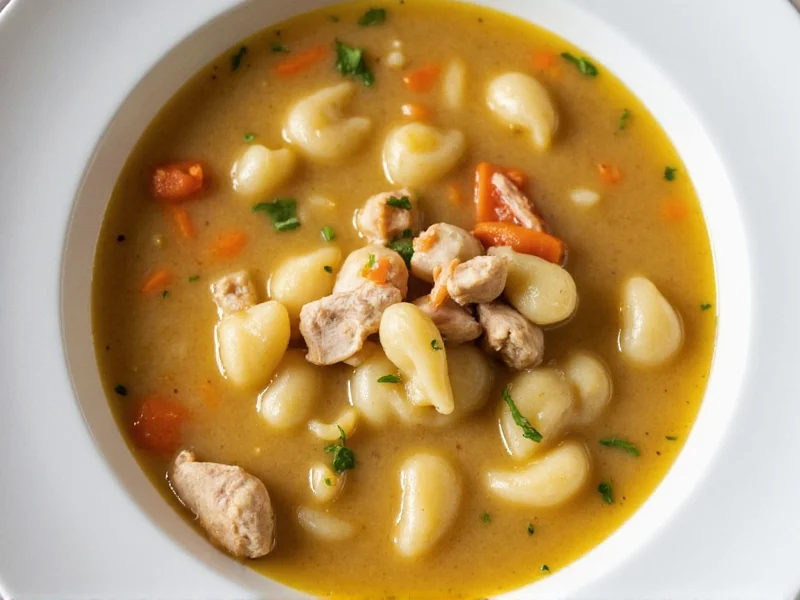Chicken and gnocchi soup transforms into a weeknight hero when prepared in your slow cooker. Unlike stovetop methods requiring constant attention, the crock pot's gentle heat extracts maximum flavor from chicken bones while keeping meat incredibly tender. The magic happens when you add pillowy gnocchi at the perfect moment - too early and they dissolve, too late and they remain undercooked. This guide reveals the precise timing and ingredient ratios for foolproof results every time.
Why Crock Pot Excels for Chicken Gnocchi Soup
Slow cookers outperform traditional methods for this specific soup through three key advantages. First, the low, steady heat gently breaks down collagen in chicken thighs without overcooking delicate vegetables. Second, the sealed environment preserves volatile flavor compounds that would evaporate during boiling. Third, the hands-off nature allows busy cooks to prepare restaurant-quality soup while handling other responsibilities.
Professional chefs confirm that slow cooking develops deeper flavor complexity in broths compared to rapid stovetop methods. The extended simmering time allows for better extraction of gelatin and collagen from bones, creating that luxurious mouthfeel characteristic of high-end restaurant soups.
Essential Ingredients for Perfect Texture
The ingredient list seems simple, but precise measurements prevent common pitfalls like watery broth or disintegrated gnocchi. Quality matters most with these components:
| Ingredient | Critical Function | Pro Tip |
|---|---|---|
| Bone-in chicken thighs (2 lbs) | Creates rich collagen-rich broth | Remove skin after cooking for cleaner flavor |
| Potato gnocchi (20 oz) | Provides signature pillowy texture | Fresh > frozen > shelf-stable for best results |
| Chicken broth (4 cups) | Flavor foundation | Low-sodium allows salt control |
| Heavy cream (1/2 cup) | Creates velvety texture | Add after cooking to prevent curdling |
Step-by-Step Slow Cooker Instructions
Follow this precise sequence for optimal results. Timing matters more than you might expect with delicate ingredients like gnocchi.
- Layer ingredients: Place chicken thighs, chopped carrots, celery, onion, garlic, thyme, and bay leaves in crock pot. Pour broth over top. Do not add gnocchi yet.
- Slow cook: Cover and cook on LOW for 6-7 hours or HIGH for 3-4 hours. The chicken should reach 165°F internally and shred easily.
- Shred chicken: Remove chicken, discard bones/skin, and shred meat. Return to pot.
- Add delicate ingredients: Stir in gnocchi, spinach, and lemon juice. Cover and cook 15-20 minutes until gnocchi floats.
- Finish: Remove bay leaves. Stir in cream and parmesan. Season with salt and pepper.
Critical Timing Guidelines
Gnocchi requires precise timing to maintain its signature texture. This table shows what happens when you add gnocchi at different stages:
| Added When | Result | Recommended? |
|---|---|---|
| Beginning of cooking | Complete disintegration into mush | No |
| 1 hour before serving | Soft, falling apart texture | No |
| 30 minutes before serving | Acceptable but slightly mushy | Barely |
| 15-20 minutes before serving | Perfect pillowy texture | Yes |
Avoid These Common Mistakes
Even experienced cooks make these errors with crock pot gnocchi soup:
- Using shelf-stable gnocchi throughout cooking: These dense varieties require longer cooking but still shouldn't be added at the beginning. Try potato gnocchi instead for better results.
- Overcooking vegetables: Add delicate vegetables like peas or fresh herbs during the last 30 minutes to preserve texture and color.
- Skipping the acid component: A squeeze of lemon juice at the end brightens flavors that become flat during slow cooking.
- Using high heat the entire time: Gentle LOW setting prevents chicken from becoming stringy and tough.
Flavor Variations for Dietary Needs
Customize this base recipe for different preferences without compromising texture:
- Dairy-free version: Replace cream with coconut milk and omit parmesan. Add 1 tbsp nutritional yeast for umami.
- Gluten-free option: Most potato gnocchi are naturally gluten-free, but verify packaging. Use certified GF broth.
- Vegetarian adaptation: Substitute chicken with mushrooms and white beans. Use vegetable broth and add 2 tbsp soy sauce for depth.
- Extra protein boost: Stir in 1 cup cooked white beans during the final 20 minutes.
Serving and Storage Tips
Proper handling maintains the soup's delicate texture through leftovers:
- Serving temperature: Ideal serving temperature is 165-175°F. Cooler temperatures make gnocchi dense.
- Leftover storage: Store in airtight container for up to 3 days. Gnocchi will absorb liquid, so add broth when reheating.
- Reheating method: Warm gently on stove over medium-low heat. Microwave causes uneven heating that destroys gnocchi texture.
- Freezing warning: Do not freeze with gnocchi included. Freeze base soup, then add fresh gnocchi when reheating.
Perfect Pairings for Complete Meal
This comforting soup stands alone as a meal, but these accompaniments elevate the experience:
- Crusty artisan bread for dipping
- Simple arugula salad with lemon vinaigrette
- Roasted Brussels sprouts with balsamic glaze
- Light pinot grigio or dry riesling wine











 浙公网安备
33010002000092号
浙公网安备
33010002000092号 浙B2-20120091-4
浙B2-20120091-4